It doesn’t matter whether you’re a beginner aquarist without much experience or an expert who’s looking for green without having to worry about upgrading lighting and CO2 installations — everyone needs a hardy, easy-to-care-for aquarium sometimes.
Easy plants are decorative, remove nutrients from the water, and provide fish with a place to hide all while being low maintenance. That means no CO2, no extra lights, and no specific water values.
Keep reading for a list of plants that will be able to survive in the hands of even the worst plant-keepers and most low-tech setups, all while looking just as lush as more sensitive plants!
Why do you need aquarium plants?
Why do aquarists keep plants in their systems? Won’t artificial plants work just as well?
Yes, artificial plants are an excellent choice if you’re only hoping to provide your fish with the sense of being in its natural environment, but you’re missing out on many other benefits when you choose not to add live plants to your aquarium.
Keeping live plants doesn’t need to be hard if you choose the right species, but if you don’t add them at all, you’re missing out on nutrient uptake, oxygen supply, and of course, natural beauty.
Nutrient uptake
If you’ve ever kept a garden before, you know that plants require nutrients to give the best flowers and harvests possible. Aquatic plants are no different and require most of the same nutrients as terrestrial plants.
Live plants help with taking up nitrates and phosphates, which are often the culprits of unwanted algae growth, making them a natural remedy for frustrated hobbyists. Live plants also help take up ammonia and nitrite, which can be beneficial when starting a new tank.
However, some of the more colorful and advanced plants need a supply of trace elements, like iron and potassium, which sometimes need to be dosed through a dry or liquid fertilizer.
All the plants on our list will be just fine with regular fish food feedings and the other waste that floats through the aquarium water!
Oxygen supply
Live plants undergo photosynthesis in the aquarium. This is the process by which plants use carbon dioxide, light, and water to make food (sugar) and oxygen.
Fish, invertebrates, and other microbes do the exact opposite: introduce carbon dioxide into the water. This means with live plants, there is a constant exchange between used carbon and new oxygen always being circulated in the tank.
However, there is also a balance between nutrient uptake, light, and oxygen, which gets more complex with harder plants; if you have really high lighting and a good amount of plants in your aquarium, you will most likely need a carbon dioxide system and fertilizers.
Luckily, the plants we recommend in this article won’t require high lighting or a carbon dioxide system!
Natural beauty
We admit some artificial plants can look better than live plants. However, artificial plants never change, and you don’t get to see your aquarium come to life with growth.
It should also be said that some artificial plants can actually be harmful to your fish as they can have sharp edges and be made of harmful materials.
How do you choose aquarium plants for your fish tank setup?
For plants, it’s best to do some research ahead of time and go to a reputable fish store that has each species labeled.
You’ll often see plants floating in tanks without any indication of their names, which will make giving proper care difficult.
One of the best things you can do is look at videos and visit forums of hobbyists who have fish tank setups similar to yours and see which plants they’ve had success with; it doesn’t hurt to do some additional research on your own as well.
When you decide on the plants you want, look for lively and vivid plants, but be prepared for them to melt slightly when you add them into your tank.
Do aquatic plants need specific water parameters?
Most aquatic plants are very forgiving of water parameters, though they might not do well with sudden changes.
As mentioned before, new plants tend to melt once you add them to your aquarium. This is due to shifts in water parameters, water flow, lighting, and general changes in environmental conditions.
While some plants can withstand less-than-perfect conditions, a good rule of thumb to note is if fish can live in your tank, then most plants can, too.
Do you need CO2 for a planted aquarium?
Carbon dioxide, or CO2, is not required for most casually planted tanks.
If you’re keeping more advanced plants or a lot of plants, then you will probably want to look into a carbon dioxide system; red and carpeting plants, for example, are especially known for needing lots of CO2.
Our Favorite Easy Aquarium Plants
Here is a list of what we’ve deemed the most undemanding aquarium plants.
Most of these species require low to moderate lighting, no fertilizers, and a very low level of care, making them good options for both beginner and advanced hobbyists alike.
Java moss (Taxiphyllum barbieri)
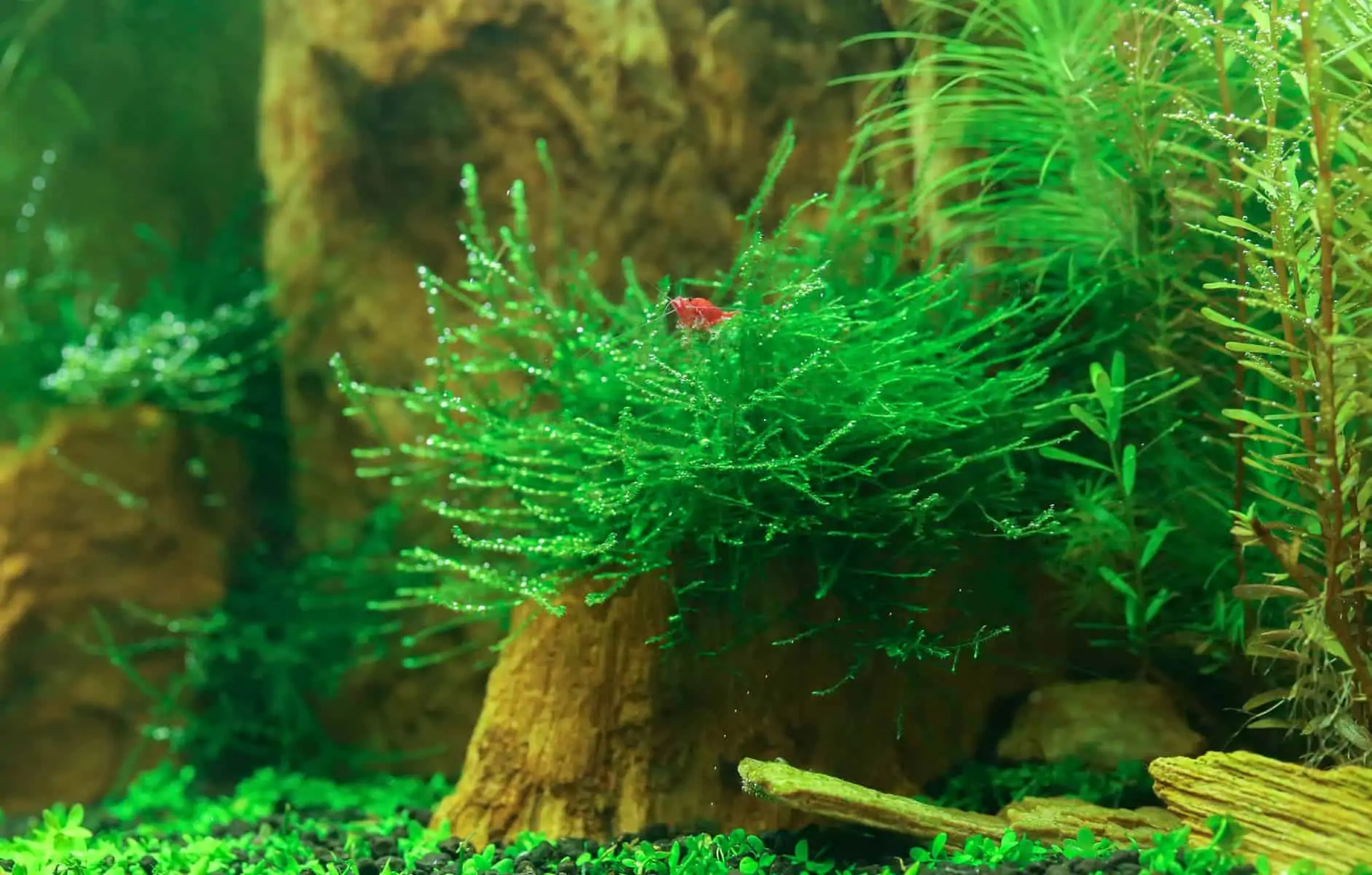
Used in aquariums throughout the world, this undemanding, hardy species is the most popular of all mosses available in the aquarium trade.
Java moss can provide hiding places for tiny fry and shrimp, but it’s also often used for decoration. You can tie it to rocks and driftwood with a fishing line or leave it free-floating in your tank.
If you’d like to get creative, floating Java moss balls or Java moss-covered coconut hides are also a great choice. You can even create a lush Java moss wall by attaching the plant to a mesh plate. Once given some time to grow, this can look pretty amazing!
When it comes to proper lighting conditions, this moss is very undemanding. It can survive in a wide range of water conditions and temperatures that are just as diverse. In fact, it’s one of the few freshwater aquarium plant species that can grow in low-end brackish water as well.
For bushy growth, trim Java moss when it gets too thick to keep the lower parts healthy and green.
If you’re interested in a more advanced type of moss, then check out our guide on Christmas moss here!
Amazon sword (Echinodorus amazonicus, Echinodorus bleheri, etc.)
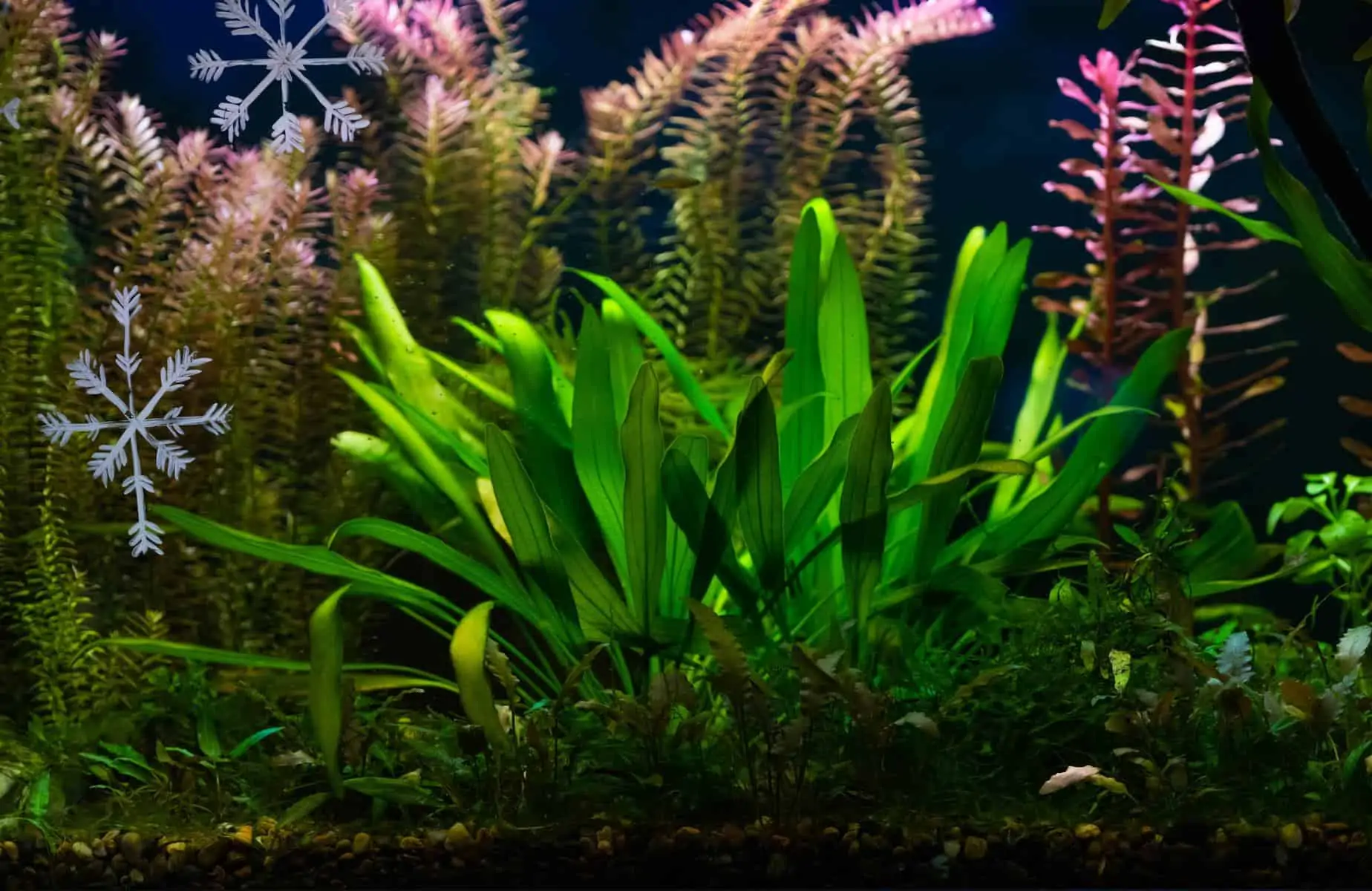
Famous for the enormous size it can reach even with low light conditions, the Amazon sword is most suitable for bigger tanks as a background aquarium plant.
Amazon sword is a root feeder, so it might require some additional root fertilizers for healthy growth; however, simple root tabs every few months are usually enough.
When provided with everything it needs, the Amazon sword can turn into a “monster plant” and reach an impressive size of almost 2 feet (60 centimeters).
Fish will appreciate the long, sword-shaped green leaf coverage, while shrimp see them as a perfect foraging spot. The fast-growing plant is ideal for excess nutrients if you’re struggling with an unbalanced tank.
Consider allowing your Amazon sword to grow above the water surface, too. If you do this, you might just be rewarded by the occasional flower.
You can find more information about Amazon sword care, planting, and propagation here.
Java fern (Microsorum pteropus)

Although Java fern can be a slow-growing plant at first, this popular species is unstoppable once it becomes established!
Java fern can survive in almost any aquarium and comes with the advantage of having hard, leathery leaves that are almost indestructible. Even notorious plant-eaters like goldfish will usually leave this species alone.
This plant doesn’t require strong lighting or specific water values, making it a great plant for beginner hobbyists and low-tech aquariums. Java fern does need to be tied down to a rock or driftwood to grow properly, as it hasn’t evolved to grow in the substrate.
Java fern is also available in many varieties, so if you don’t like the typical assortment, go for Windeløv-, narrow leaf-, trident- or Philippine Java fern. Each has a different growth pattern and leaf shape, meaning there’s an ideal choice for every aquarium.
A full Java fern care sheet can be found here.
Vallisneria (Vallisneria spiralis, gigantea, etc.)
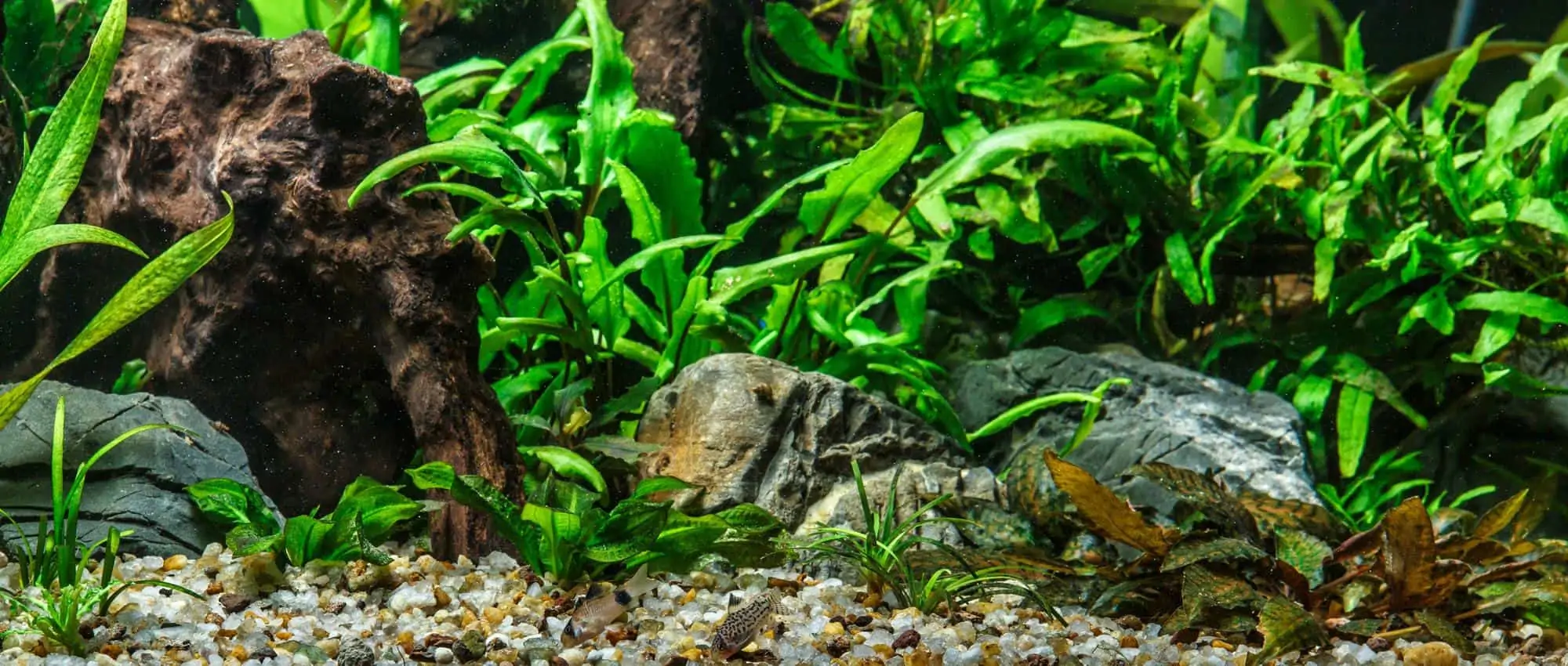
Vallisneria is another tall plant with subspecies suitable for almost every aquarium.
This species can easily adapt to a wide range of water and light conditions. Although it doesn’t have the fastest growth rate, you will quickly see runners with small new leaves appear around the mother plant.
If the runners are not removed, Vallisneria will form a dense field in a relatively short amount of time. This is a great background plant option if you keep fish that appreciate being provided with plenty of covers.
Do keep in mind that the soft leaves of Vallisneria may be seen as a snack by some fish species — it’s even edible for us humans! This can sometimes make keeping it with herbivorous fish tricky.
I like to grow Vallisneria in tanks that have shy fish like bettas and dwarf puffers. I’ve found that there’s no need to worry about never seeing your fish again.
As paradoxical as it might sound, having the option to retreat to a safe place actually gives species like these the courage to come into the open more often.
A full care sheet on this green-leaf giant can be found here.
Amazon frogbit (Limnobium laevigatum)
If you’re looking for a hardy, fast-growing floating plant to provide your fish with some shade, look no further!
Amazon frogbit is one of the most popular floating plants out there, and its easy care makes it an ideal plant for beginners.
Frogbit grows very quickly, even in less than ideal water conditions. It helps keep your water parameters stable between maintenance rounds by absorbing extra nutrients, like nitrates and phosphates, which can lead to algae growth over time.
Its long roots make a great place for skittish fish to hide in and help prevent stress while the shade provided by the leaves can help break up the lighting throughout the tank.
Remember, frogbit doesn’t handle harsh lighting or being underwater for extended periods very well. A low-light environment is better for this species than a high-tech setup with a very strong lamp.
If left to multiply, it can also suck up a majority of the nutrients in your tank. But with the right care, it has many benefits!
Anubias (Anubias barteri, Anubias nana, etc.)
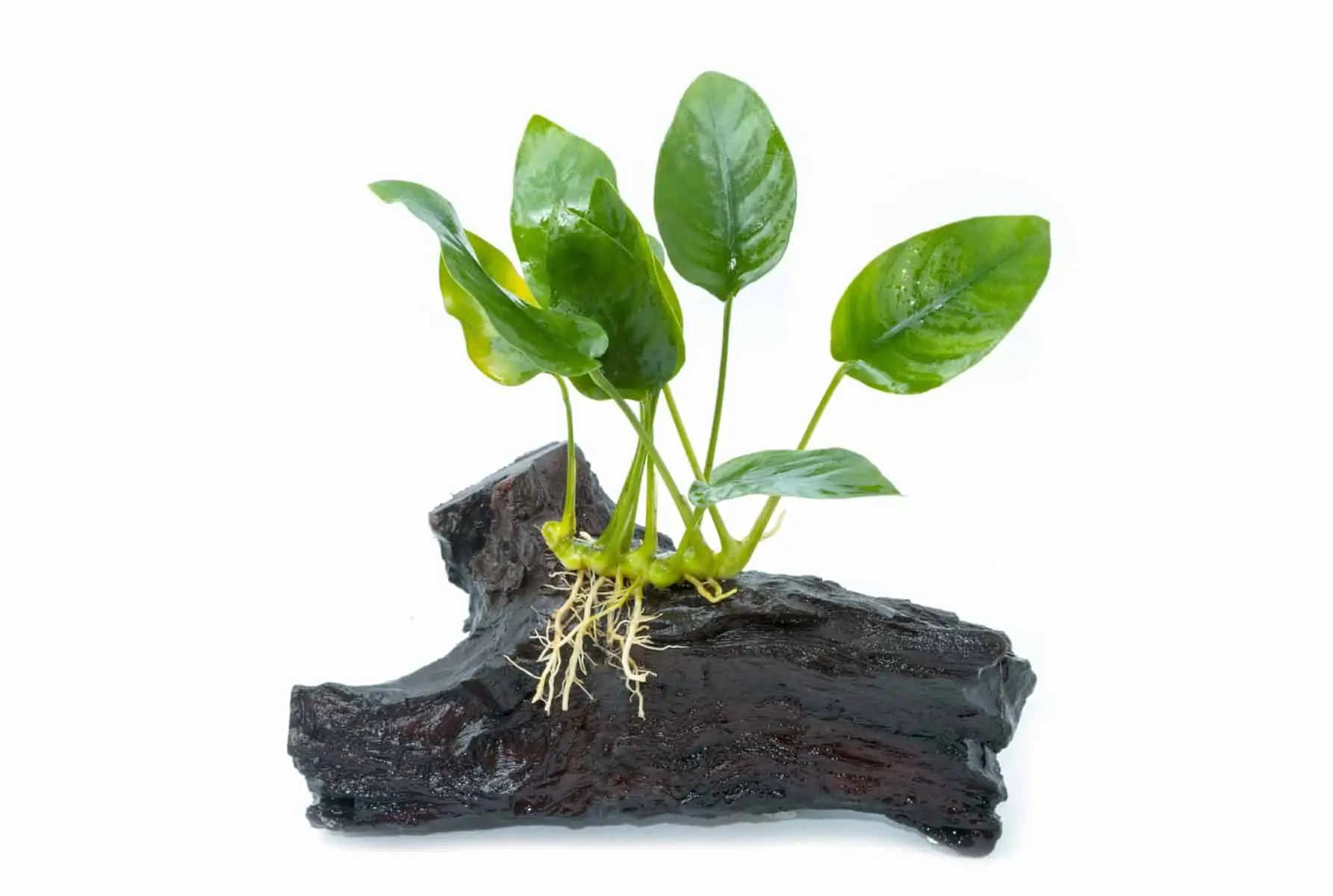
Anubias is one of the few plants that actually prefer low-light conditions. This, along with the fact that even plant-eating fish seem to leave it alone, makes it a great addition to many types of aquariums.
Anubias won’t appreciate being planted in the aquarium substrate; it does best when tied to or glued down to rocks or driftwood. It looks especially good in small groups of multiple plants and the broad leaves make a great sitting or sleeping place for fish.
Anubias is primarily a foreground plant, but hobbyists get creative and can find a spot for them at all levels of the tank.
Trim your Anubias regularly by removing leaves now and then with a pair of scissors to keep it looking good. If you allow it to grow above the water, it may even reward you with a lovely white flower!
Crypts (C. wendtii, C. spiralis, and C. crispatula, etc.)
If you’ve just bought a crypt, you may be disappointed to see it dying within a few weeks. However, there is no reason to be discouraged!
Cryptocoryne species are well known for their tendency to shed old leaves (this is called melting) after being moved from one aquarium to the next; most times, they quickly grow back into a larger plant.
Crypts do well in low-light settings, and although their slow growth rate can be discouraging, they can quickly start to have bushy growth after they’ve acclimated!
Cryptocoryne is available in many different varieties, including an attractive red form and a dwarf form that has compact growth for carpeting purposes.
Anacharis (Egeria spp.)
Anacharis is a very popular type of plant for beginners, though more advanced hobbyists will consider it a terrible weed!
Anacharis has an optimal growth rate for hungry herbivorous fish and invertebrates, and species that need some green in their diets, like goldfish, will appreciate freshly-grown plants.
This species of plants’ fast growth rate is also helpful if you need to combat an algae problem as it can quickly take up nutrients. However, this balance will need to be watched closely so there are still some nutrients left for other plants.
Anacharis can be left floating but grows fine when planted as well. Note that this popular plant might melt in your tank but should be replaced by fresh, lively leaves very quickly.
Bucephalandra spp.
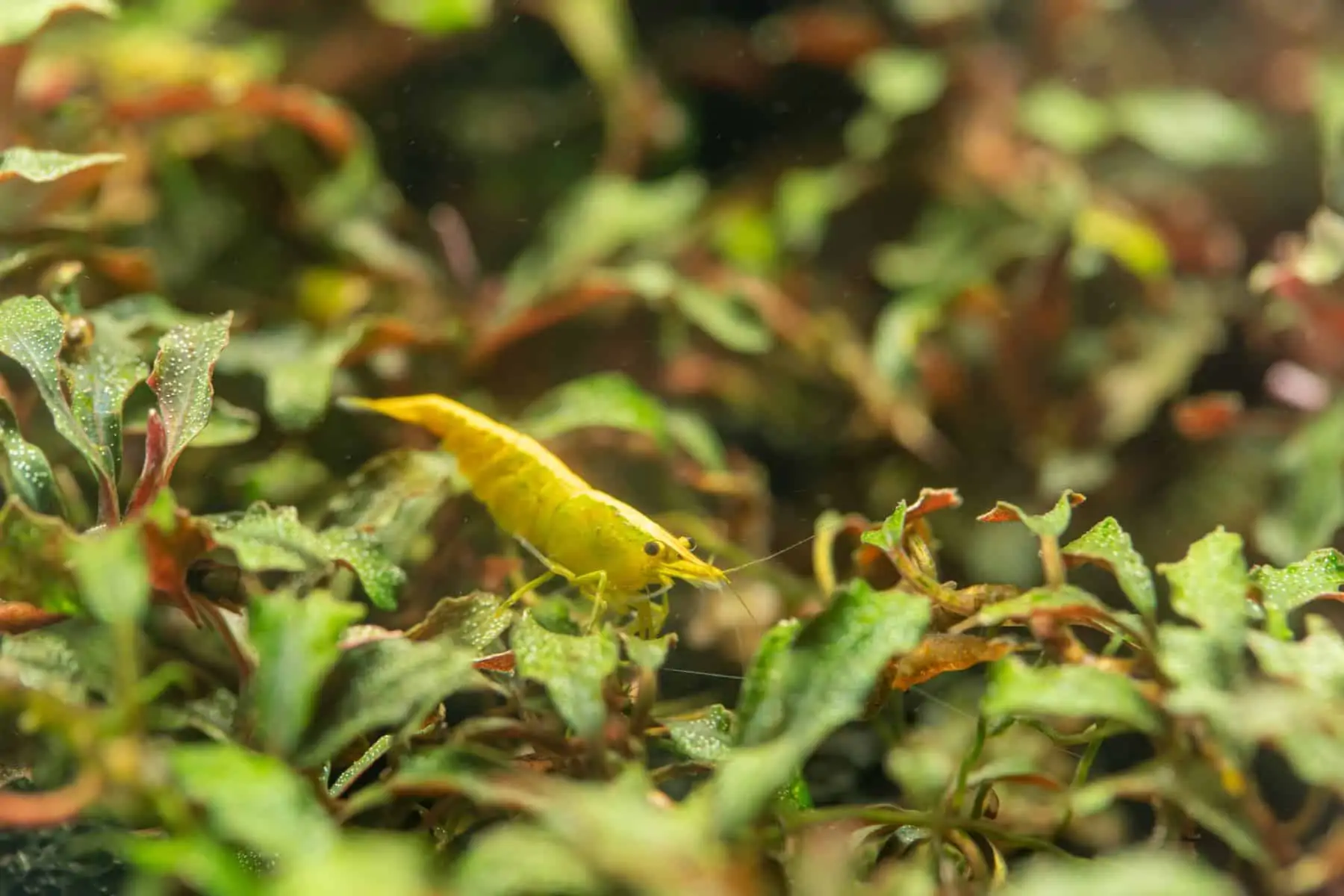
Plants from the genus Bucephalandra seem endlessly captivating to aquarists; their beautiful colors and different sizes make it tempting to want to collect every species out there.
Bucephalandra care is pretty similar to that of Anubias and Java fern. This plant is also a rheophyte that grows on rocks and driftwood in its natural habitat in Borneo. It doesn’t need a high light level and has adapted to grow both submersed and emersed.
There is an endless variety of Bucephalandra species out there. Many haven’t even been scientifically named yet, and new varieties are regularly being discovered.
The most popular variety in aquarium stores today seems to be ‘Wavy Green‘, which is named after the characteristic bends in its leaves.
Conclusion
As you can see, there is a whole assortment of easy freshwater plants that don’t require the fanciest lighting or tank setup; and luckily, most of them are very cheap as well!
Remember, aquarium plants should never be released into local lakes or rivers. Doing this can cause damage to natural habitats and native species might be outcompeted for nutrients, light, and space.
If you have to get rid of unwanted plants, you can sell them, destroy them, give them away or dispose of them properly. Composting is also a great option.
If you have any more questions about the plants on this list or want to share your own experiences, don’t hesitate to comment below!

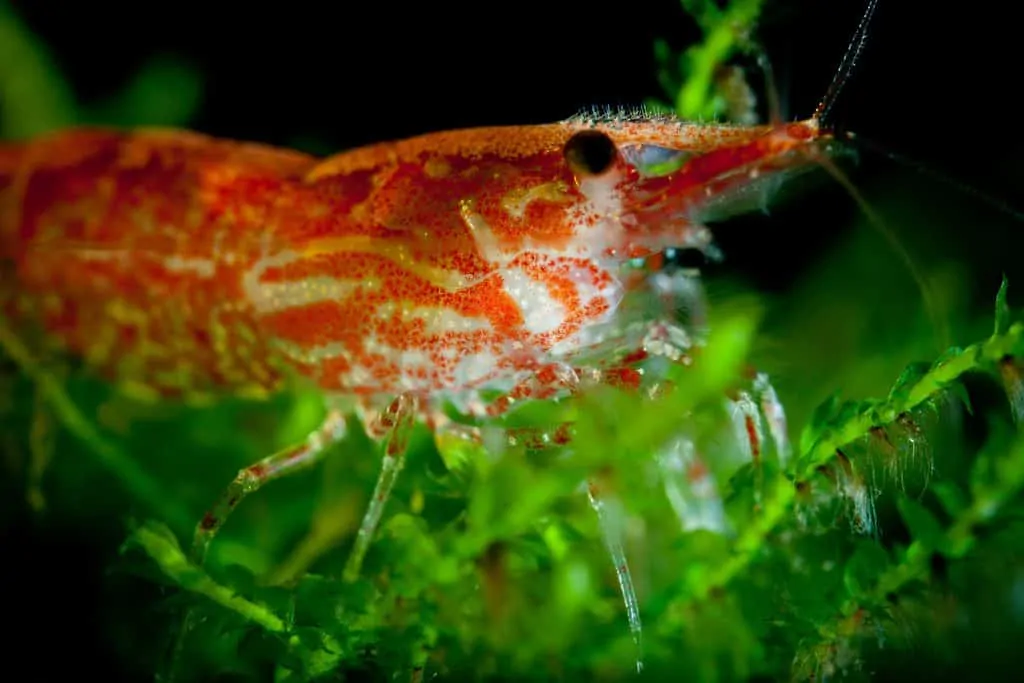






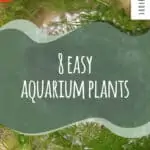
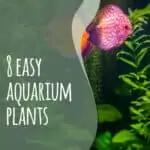
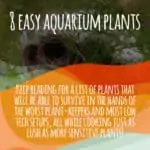
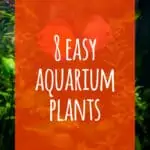
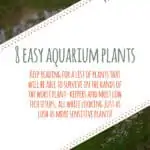

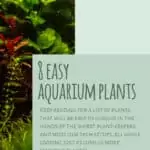
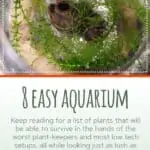
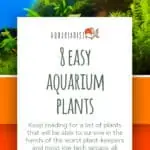
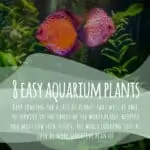
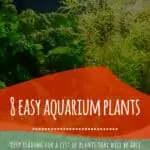
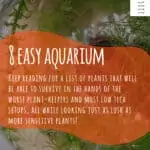
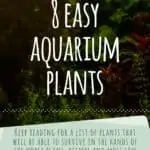
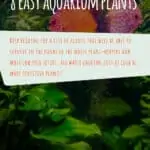
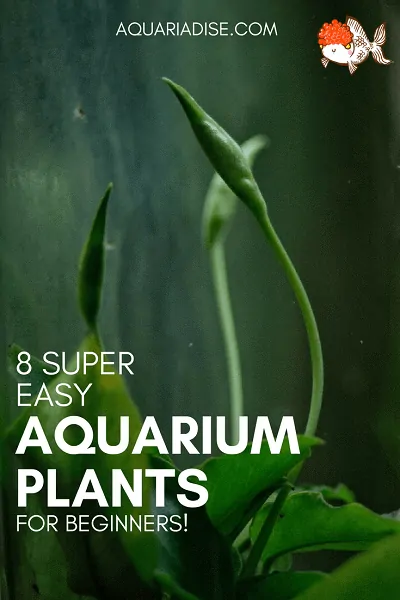

Hi am new to the aquarium, I like my aquarium to greenery, but it should be simple and easy to maintain can you suggest me one. Thanks in advance.
We fully agree! Happy plant-keeping!
I like hornwort for a super easy plant. It grows really fast and doesn’t put out any roots making it easy to pull clumps out to remove nitrates.
Hi David!
Yes, hornwort is one of the easiest plants to grow and can actually be a great plant to control algae in tank and pond systems alike. However, a lot of hobbyists tend to stay away from it as it can quickly overtake systems and deplete the water of important nutrients, leaving other plants without any. We have a full article on the species here: https://www.aquariadise.com/hornwort/!
Thank you for this article, it was so informative! Now it’s stupid question time! Can I have plants and snails or do I have to pick one? Also, if I keep the blue light spectrum on at night will it cause harm to plants/fish?
Hi Jessica!
Thank you! There are no stupid questions in this hobby, trust me. Every single tank is different.
Most times, you will end up with snails with your live plants involuntarily. If you don’t treat/quarantine your live plants before you put them into your main display, you will most likely introduce snail eggs/baby snails; even if you do treat your plants, there is a decent chance that they will survive anyway.
In general, snails and plants can live happily together in the same tank. Snails usually stick to eating algae or dying/decaying leaves.
As for your lights, it’s a little trickier and depends on your tank, but most agree that blue lights/moonlights should not be kept on for the entirety of the night; fish do just fine in total darkness and additional light can feed algae. Maybe consider only having them on for a few hours before and after you shut off the other spectrums.
Thank you for responding! It is so helpful to get questions answered
No problem!! Feel free to ask about anything and keep us updated!
Would you have any suggestions for easy carpet plants for a nano tank other than grass or moss?
Thanks.
My vote is on dwarf hairgrass (which is very sturdy). If you want something a little funkier, Cladophora algae – I think you can attach it to mesh and just use it to cover the entire aquarium floor. 🙂
Do you know of anything (easy carpet plants) with regular leaves? I found one called micranthemum but I don’t know how easy is. Thanks!
By regular I mean roundish
Micranthemum ‘Monte Carlo’ is a carpeting plant and definitely one of the easier ones. It does still need a lot of light. Hemianthus micranthemoides is similar but a little taller. 🙂
Perfect. Thanks
i have a small betta tank and i want to add some greens to it but the problem is that the the local store doesn’t have any of them, so are their any common or wild or every day plants which i can add to my tank
I’m not sure! And it depends entirely on your location/climate. Are there no online stores you can order from? Online shops have a much wider variety of plants available usually.
Hi
Since its been awhile I don’t know rather or not you’ll reply but in a big enough tank could all these plants do well in the same tank?
Thanks
Not all of them, no, but most can. Vallisneria likes a higher pH and harder water than the rest 🙂
This is what i’m looking for. I always struggle with the plant cause most of them need high maintenance. Thank’s mate
I’ve had java ferns before, and they have always died
always.
i dunno why
yup they are fairly easy to maintain
and Anubias Nana is one of the more appealing midground plants you’ll find in aquascaping
what is a root tab thanks
Root tabs are small tablets that can be placed near the roots of plants that require a little extra iron to help them grow much faster and larger. Seachem tabs have great reviews.
tabs have great reviews.
I want to buy amazon sword …I have gravel substrate and no co2 product and no fertilizer…so can it survive?
I think so! Although I would definitely invest in some cheap root tabs if you’re going to be at the aquarium store or ordering aquarium stuff anyway 🙂
Yes it will survive. ..i have a low light aquarium without co2, and no root tabs…i bought it with just 6 leaves and they started to die so i just pulled the leaves that were dying and surprise new leaves grew now after 2 months i have a beautiful amazon sword with more than 16 leaves and all without special care just turn on the light when i come back from work at 6pm and turn it off when i go to sleep at 9-10pm thats all
Hello,
Recently I brought a tyre track eel, and intending to setup a new aquarium for it. What plants will be good for it and easy to manage?
Also, can these plants work in a sand substrate or is it better to buy some that’s on a bit of wood?
Thanks.
Hi! Wow, that must be a huuuuuge tank! In these 100+ gallon tanks I would go for larger plants like Amazon swords, large anubias varieties and vallisneria. Amazon swords and vallisneria work on a sand substrate, anubias should be tied to rock or driftwood.
Good luck! 🙂
Can I put amazon sword in a basic sand substrate and expect to just grow / survive?
Sure! And if it doesn’t, some cheap root tabs like these should usually fix any problems, my Amazon swords grew very well this way 🙂
should usually fix any problems, my Amazon swords grew very well this way 🙂
Thanks for the help.
Are you familiar with Limnophila aquatica or Limnophila hippuridoides?
Are these easy to keep? I’ve very often had artificial versions of these and was wondering if live ones would look nicer, my artificial ones become full with gunk after awhile.
Hi!
No, I don’t have experience with them as I haven’t ever really kept stem plants. Limnophila aquatica is very easy and you should have no problems with it. The other plant requires a bit more light, but is still not considered super challenging!
Thanks for the information!
Going out tomorrow to LFS, might see if I can get a plant or two and try them out 🙂
Sounds good! Let me know how you liked them 🙂
I just hope they’ll stay alive! 🙂
I have swords in my gravel and my sand tanks. They do ok in he gravel. They do phenomenally well in the sand. Both tanks have a few root tabs.
I enjoyed the article and it gave me much food for thought. I was told by a shop keeper to try the liverwort, Monosolenium tenerum , as an easy starter for a cool water tank. It has not died, but in 6 months has grown little. Unruly, I keep it in a folded aluminum cage made from an outdoor grill, and it has only just protruded from it. This in a 15 gal. tank with lots of water movement and oxygen content. It gets some natural light and 10-12 hours of a T8 full spectrum. Anyone with success or suggestions?
Gregg
I’m not sure what you mean by the aluminium cage, but I did some reading up on this plant as I don’t have any experience with it at all and it seems very interesting! It’s supposed to be pretty easy to grow in a huge range of conditions, unlike its more common cousin Riccia, so I’m not sure whats going wrong for you! You may want to ask around on an aquarium plant/aquascaping centered forum. 🙂
I’ve heard many people say that Amazon swords are easy to maintain but I personally had a very bad experience with these plants. I have been trying these plants from the past one year. They remain stable for 3 weeks and after that the leaves slowly start melting and they become transparent. New leaves never grow. I’ve planted more than 100 amazon swords in the last one year and lost all of them except one plant which is doing really well. I have no clue that why this one plant is growing crazy while all the remaining have died. I am using a good substrate, enough lighting (2 watts per gallon) and a Co2 injection as well. Am I missing something?
Oh dear, sorry you’re having trouble with your Amazon swords! Mine always did great, even in an empty abandoned tank with the lights off. Do you use root tabs? Those are usually recommended for Amazon swords. That’s the only thing I can really think of. Good luck! 🙂
I’ve heard that java moss does well in flowing water, making it ideal for use as a filter flow diffuser. I’m planning on getting a mesh (like you would for carpeting java moss) and putting that in front of the out-flow of my filter. Is the thing about java moss liking flowing water even true? Do you think my plan will work? Thanks!
That’s a pretty interesting idea. Java moss is indeed known for liking flowing water, but I’ve never heard of using it to battfle a filter. I think it could work though! Let me know how it works out. 🙂
Would the amazon frogbit oxygenate the water? And would it give off any algae for my fish?
It grows quite quickly and would make a good oxygen plant, although if you let it cover the surface completely it may block oxygen from entering the water. Plants cannot give off algae, but if any algae forms naturally it may do so in the roots. 🙂
My husband just got me a 27 gallon cube tank with really bright led lighting. We are keeping a tank full of glo fish and using the blue LEDs a lot due to wanting to see the true colors of the fish any suggestions on the best type of plant for my tank
I can’t tell you much about the best type of plant for your tank, but the ones listed here will all work well and are not difficult to take care of. It mostly depends on your personal preferences and what you think looks best!
Have got really excited after seeing ur post. Thanks..
I want to know which of these would also not need a substrate..
Java moss, Java fern and Anubias don’t need substrate!
HELP!!!!! Anubias plant dieing!!!! It was attached to driftwood when I bought it, and the leaves were already yellowing. I cut off the the yellow parts of the plant, and It seemed to be doing fine. After a snail invasion, I removed the anubias, exterminated the snails, and while exterminating the snails I kept the anubias in a stainless steel container, with its leaves out of the water, roots and rhizome under water. It still seemed fine. After the snails where removed, I trimmed off any yellow bits again and moved the plant back into the aquarium. A few days later it started yellowing again, and large brown blotches started appearing on its leaves. The water temperature currently is 20 degrees C. When I first placed the plant in, It was 16 degrees C.
Although I don’t have much personal experience with Anubias so I can’t tell you for sure, I think yours may just be recovering from the shock of being moved twice and having its leaves out of the water. Unless you really don’t see any new growth appearing at all, I think it will grow back to normal in a while. This could take a few weeks though!
Thanks!
also, do you know if iron supplements would help it grow faster as well? The anubias attached to driftwood was very expensive, so I would be heartbroken if it died.
Going plant shopping today with this list in hand for my newly purchased 55 gallon. Very excited! Thank you so much for this simple, precise list!!!
So great to hear this list was helpful to you! You should be able to make a beautiful aquascape with these plants.
I found it very helpful I new to keeping fish thank you so much
Thank you so much for this article. My mother was a grade school teacher, and we always had aquariums when I was growing up. Now I have two little boys, and we are starting our first aquarium (10 gal). We are waiting for the water to cycle, and I’m already dreaming of second larger tank. These suggestions for plants are just what I was looking for.
So glad to hear this was helpful to you! These plants will definitely do great in a 10 gal. Good luck! 🙂
Update a few months later: Initially, I got java fern and anubias nana for my 10 gal. tank (6 tetras and 3 cory catfish) because it has low LED lighting. I’m so happy. They are really doing well. I was spurred on and decided to try water wisteria. It’s not on your list of beginner plants, but I’d read that it grows fast and easily. I also read that it may look different if grown in water as opposed to partially submersed and that it may need nutrients. My purchase included 4 pieces, so I decided to put 2 in the tank and 2 in a covered glass jar (like a terrarium). Unfortunately, they didn’t do well in the tank, but flourished in the terrarium. I’m going to try adding root tabs to the water, but I still may not have enough light. It may end up being a failed experiment, but I’ve enjoyed watching the plants grow and the fish seem to like them too 🙂
Thank you for the update, I love hearing how things worked out. Glad the java fern and anubias worked for you! I don’t have personal experience with water wisteria, although I know it’s supposed to be a pretty easy to grow. Curious to hear how it does with some root tabs! Those can really make a difference.
Well, I didn’t know my anubias nana was going to bloom! That is so cool! The root tabs seemed to be good for my water Listeria, but it was also good for a brown algae that developed. Now it seems the Listeria is getting soft at the bottom and might melt away.
Yes, anubias do bloom when grown in the right conditions! For your other plant problems you may want to ask the members on an aquascape forum, they have much more experience with this sort of thing than I do. Good luck!
now that i have an ide on what to get, i dnt have to worry about co2
Yep! Adding CO2 isn’t necessary with these plants 🙂